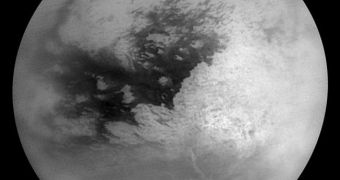The largest Saturnine moon Titan is one of the most interesting objects in the solar system, and now experts say that some of the things which make it unique here may in fact be the norm elsewhere in the Universe. This could be especially true around red dwarfs.
In a new study, published in the April 2 online issue of the esteemed journal Planetary and Space Science, two investigators demonstrate that exoplanets orbiting red dwarf-class stars or those who do not orbit any star (called rogues) are very likely to look just like Titan does.
What experts are most interested in discovering are places where liquid organic compounds fill large surface oceans. This happens on Saturn's largest moon to some extent, in the sense that there are no oceans there, only many large lakes.
On the other hand, the object is clouded by a thick, hazy atmosphere, which features a complex methane cycle. This cycle operates in very much the same way as the water cycles works here on Earth.
It is not unfeasible to consider the possibility that methane-dependent lifeforms developing on Titan over the course of billions of years. Similarly, it wouldn't be unfeasible to think that this also happened on exoplanets featuring the same surface and atmosphere types.
“Astrobiology has historically focused on liquid water as the habitable liquid, and certainly it works well on Earth, but there is growing interest in the possibility of liquid methane,” explains NASA Amest research center planetary scientist and researcher Christopher McKay.
He and colleague Ashely Gilliam, who is also a planetary scientist, decided to construct a computer simulation that looked at whether liquid methane lakes could endure on an exoplanet that did not revolve around a Saturn-class gas giant.
They instead simulated the behavior of the moon when put around a dim M4 red dwarf star. “The reason we chose to look at red dwarf stars is because they are the most abundant stars in the galaxy,” Gilliam explains, quoted by Space.
“It is much more likely that we would find another Titan-like world orbiting an M-star than we would orbiting a star like our Sun,” the investigator adds.
Though theoretically red dwarfs produce less light than Sun-like yellow dwarf stars do, they generate more infrared radiation, which passes easier through hazy atmosphere. At the same time, the chemicals in the air produce a strong greenhouse effect.
This phenomenon contributes to keeping exoplanets warm, even if at first glance they should be frozen several times over.

 14 DAY TRIAL //
14 DAY TRIAL //